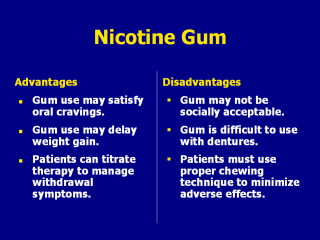| front |1 |2 |3 |4 |5 |6 |7 |8 |9 |10 |11 |12 |13 |14 |15 |16 |17 |18 |19 |20 |21 |22 |23 |24 |25 |26 |27 |28 |29 |30 |31 |32 |33 |34 |35 |36 |37 |38 |39 |40 |41 |review |
 |
Advantages of nicotine gum include the
following: Gum use may satisfy oral cravings. Gum use may delay weight gain (Fiore et al., 2000). Patients can titrate therapy to manage withdrawal symptoms. Disadvantages of the gum include the following: Gum chewing may not be socially acceptable. Gum may stick to dental work and dentures. Patients must use proper chewing technique to minimize adverse effects. The gum appears to be particularly helpful with patients who have weight gain concerns or who report boredom as a trigger for smoking. It may also be advantageous for persons who need to more tightly titrate nicotine levels to avoid distraction or irritability withdrawal symptoms in order to avoid injury, such as transportation workers or persons who work with heavy machinery. Fiore MC, Bailey WC, Cohen SJ, et al. Treating Tobacco Use and Dependence. Clinical Practice Guideline. Rockville, MD: U.S. Department of Health and Human Services, Public Health Service, 2000. Slide is used with permission, Rx for Change: Clinician-Assisted Tobacco Cessation. Copyright © 1999-2007 The Regents of the University of California, University of Southern California, and Western University of Health Sciences. All rights reserved. |